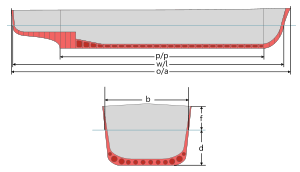Freeboard (nautical)

In sailing and boating, a vessel's freeboard[1] is the distance from the waterline to the upper deck level, measured at the lowest point of sheer where water can enter the boat or ship. In commercial vessels, the latter criterion measured relative to the ship's load line, regardless of deck arrangements, is the mandated and regulated meaning.[2]
In yachts, a low freeboard is often found on racing boats, for weight reduction and therefore increased speed. A higher freeboard will give more room in the cabin, but will increase weight and may compromise speed. A higher freeboard also helps weather waves and reduce the likelihood of being washed over by full water waves on the weather deck. A low-freeboard boat is susceptible to taking in water in rough seas. Freighter ships and warships use high freeboard designs to increase internal volume which also allows them to satisfy IMO damage stability regulations due to increased reserved buoyancy.
Notes
- ↑ "IMO". 2008. Retrieved 2008-04-16.
- ↑ board "Dictionary.com definitions of "Freeboard"" Check
|url=value (help). Retrieved 2008-06-23.1. Nautical.
- a. the distance between the level of the water and the upper surface of the freeboard deck amidships at the side of a hull: regulated by the agencies of various countries according to the construction of the hull, the type of cargo carried, the area of the world in which it sails, the type of water, and the season of the year. Compare load line.
- b. (on a cargo vessel) the distance between the uppermost deck considered fully watertight and the official ship's load line.
- c. the portion of the side of a hull that is above the water.
References
- Hayler, William B.; Keever, John M. (2003). American Merchant Seaman's Manual. Cornell Maritime Pr. ISBN 0-87033-549-9.
- Turpin, Edward A.; McEwen, William A. (1980). Merchant Marine life. Officers' Handbook (4th ed.). Centreville, MD: Cornell Maritime Press. ISBN 0-87033-056-X.